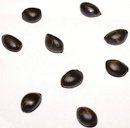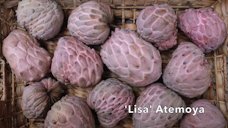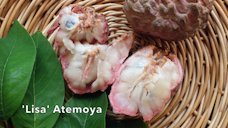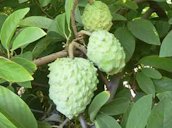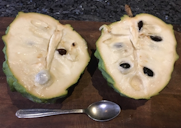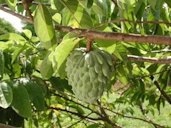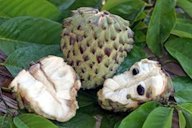| Atemoya - Annona cherimola x A. squamosa | |||||||||||||||||||||||||
|---|---|---|---|---|---|---|---|---|---|---|---|---|---|---|---|---|---|---|---|---|---|---|---|---|---|
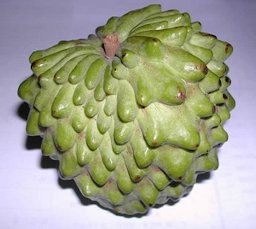 Fig. 1 Atemoya fruit Annona cherimola x A. squamosa 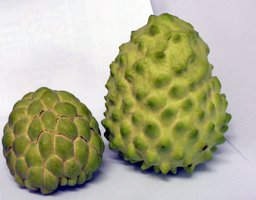 Fig. 2  Sugar apple (left) and atemoya (right)  Fig. 3  Atemoya flowers 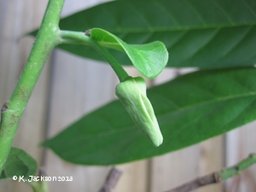 Fig. 4  Flower 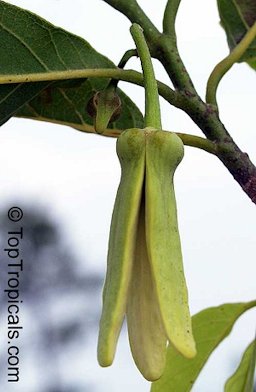 Fig. 5 Flower in female stage  Fig. 6  Sap beetle entering an atemoya flower 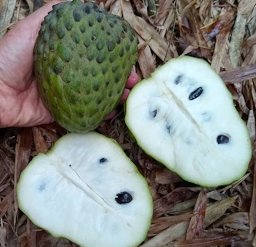 Fig. 7 Atemoya from Tropical Nursery in Vista, California. 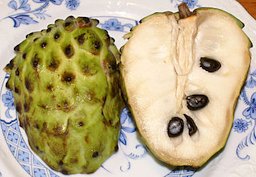 Fig. 8  Atemoya from Taiwan 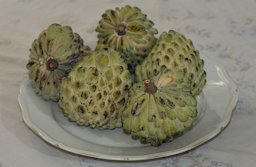 Fig. 16  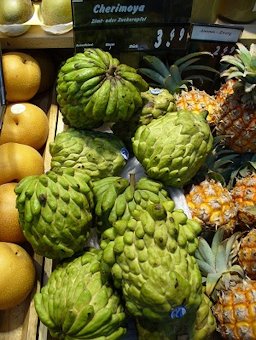 Fig. 17 Atemoya in New Zeland grocery store 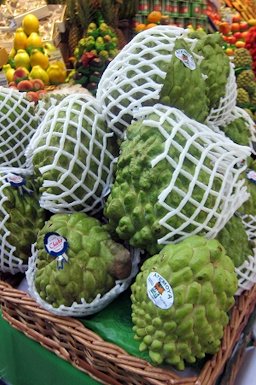 Fig. 18 São Paulo - Sé: Mercado Municipal de São Paulo - Atemoya 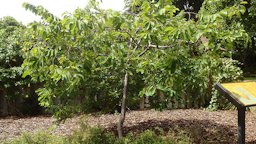 Fig. 19  |
Scientific
name Annona cherimola x A. squamosa, and A. cherimola x A. squamosa hybrids Common names English: atemoya; Taiwan: pineapple sugar apple; Cuba: anón; Venezuela: chirimorinon; Israel and Lebanon: achta; Tanzania: stafeli dogo ("mini soursop"); Vietnam: Mãng Cầu Dai Synonym No synonyms are recorded for this name Relatives Sugar apple (A. squamosa), cherimoya (A. cherimola), soursop (A. muricata), custard apple (A. reticulata), pond apple (A. glabra), ilama (A. diversifolia) 2 Family Annonaceae (annona family) Origin Derived from man-made and natural hybrids, Florida, USA USDA hardiness zones 10-12 Height 25-30 ft (7.5-9 m) Crown Trees may have a rounded or possess a asymmetrical canopy Plant habit Short-trunked, the branches typically drooping, the lowest touching the ground Growth rate Fast Pruning requirement Regular pruning in the spring to maintain height to 6-12 ft 2 Leaves Semi-deciduous, alternate, elliptical, leathery, less hairy than those of the cherimoya; and up to 6 in (15 cm) in length Flowers Long-stalked, triangular, yellow, 2 3/8 in. (6 cm) long and 1 1/2 to 2 in. (4-5 cm) wide; bears protogynous, hermaphroditic flowers; and self-pollination is rare 2 Fruit Aggregate fruit; conical to ovate; surface smooth, bumpy, or pronounced protuberances; pulp is white/creamy white, with a custard-like, sweet flavor; dark brown seeds Season From Aug. to Oct.; sometimes during Dec.and Jan. if no frost occurs and leaves remain on the tree 2 Light requirement Full sun Soil tolerances Well adapted to most well drained soil types including the sands and limestone based soils of south Florida 2 pH preference 6.0-6.7 6 Drought tolerance The drought tolerance of atemoya is less well understood; prolonged drought stress may reduce the percent fruit set, fruit size, and crop yields 2 Flood stress Atemoya trees may be grafted onto various rootstocks and their flood tolerance varies with rootstock 2 Soil salt tolerance Is not tolerant of saline soil and water conditions Cold tolerance 26-27 °F (-3.4 to -2.8 °C) 6 Plant spacing At least 25-30 ft (6.7-7.6 m) from adjacent trees and structures 2 Roots Relatively shallow and weak root system Invasive potential * None reported Pest resistance See below Known hazard Seeds contain toxic insecticidal substances Reading Material Atemoya Growing in the Florida Home Landscape, University of Florida pdf Atemoya, Fruits of Warm Climates The Atemoya, Archives of the Rare Fruit Council of Australia The Atemoya, Tropical Fruit News, RFCI Atemoya, Florida Gulf Coast University pdf The custard apple grown in Australia is a hybrid of the sugar apple (Annona squamosa) and the cherimoya (Annona cherimola). More recently, hybrids have also been developed with Annona reticulata. In America the fruit is known as Atemoya. Note: It has for many years mistakenly been called custard apple or cherimoya in Queensland and New South Wales. 5
Origin Not a species, but a hybrid created in Florida between cherimoya (Annona cherimola) and sugar apple (A. squamosa). One of the best Annonas, often sweeter and fruitier flavored than the cherimoya. Typically 1 ½ to 2 lb, custard-like flesh. Grows in hot tropical areas. The first cross was made in 1908 by P.J. Wester, a horticulturist at the USDA’s Subtropical Laboratory in Miami. Subsequently, in 1917, Edward Simmons at Miami’s Plant Introduction Station successfully grew hybrids that survived a drop in temperature to 26.5°F, showing atemoya’s hardiness derived from one of its parents, the cherimoya. 3 The fruit resulting from the cross between the sugar apple and the custard apple were given the name "atemoya", a combination of "ate", an old Mexican name for sugar apple, and "moya" from cherimoya. 3 Distribution Atemoyas are grown throughout the subtrop- ics and tropics. In Florida, atemoya production is restricted to warm locations along the lower southeast and southwest coasts. However, home landscape trees may be found along the southeastern shore of Lake Okeechobee and in warm protected locations along the lower east and west coasts. 2 Description A premium fruit with few equals, the atemoya is on the verge of becoming a popular dooryard fruit in south Florida. It is a member of the venerable Annona genus. Scarceness, superb flavor, and overall quality make this species a valuable addition to any home garden. The tree has some cold tolerance, although growth is generally limited to the southern half of the peninsula. The atemoya is attacked by several insect pests and tends to be a shy bearer absent pollination by hand. 6
Leaves Leaves are green, hairy when young, smooth when mature, elliptic, ovate or lanceolate in shape. Leaves are often variable in shape on the same tree. Leaves may be 4 to 8 inches (10-20 cm) long and 1.5 to 3.25 inches (4-8 cm) wide. Trees are semi-deciduous; however, the rate of leaf drop depends upon the severity of cool winter temperatures and leaf disease pressure, which is exacerbated by late summer-fall rainfall. 2 Flowers Flowers emerge during mid- to late spring as trees flush with new vegetative growth. Flowers are produced singly or in clusters of 2 to 4 from leaf axils on one-year-old shoots or new growth. The flowers are composed of 3 green colored, fleshy petals, 3 small, inconspicuous sepals, and numerous unicarpellate (single ovary) pistils on a common receptacle. 2 An atemoya flower, in its female stage, opens between 2:00 and 4:00 pm; between 3:00 pm and 5:00 pm on the following afternoon, the flower converts to its male stage. 3 Flowers in the female stage are characterized by only a slight opening of the petals (Fig. 4) and a glistening appearance to the stigmatic surfaces. Flowers in the male stage are characterized by flower petals being wide open, petals may easily fall when touched and stamens may have a brownish color. This arrangement of having male and female flower parts functional at different times during the day makes cross pollination among different flowers necessary. 2 Atemoya trees produce flowers on 1- to 2-year old wood and newly emerging shoots. They may have multiple blooms, with the main bloom from Apr. through June and a smaller bloom during July. 2 Pollination The majority of Annonaceae are pollinated by beetles, although some are pollinated by thrips. The activities of beetles in the flowers (Fig. 5), including feeding, mating, and quiescence, result in prolonged visits from several hours to a few days while the flowers advance from the female to the male phase. 1 In Florida, flowering of atemoyas begins in April, and sugar apples in May, and continues until early August. Atemoyas and sugar apples are most often pollinated by nitidulid beetles, which breed and feed in decaying fruits or sap flows. The beetles are attracted to the fruity, fermenting odor of Annona flowers, especially when they are hungry. The number of beetles per flower affects the likelihood of fruit set, and also the quality of the fruit in some cases. All studies provide evidence for increased fruit set as numbers of visiting beetles increase. In Florida, about nine species of native and exotic nitidulids (sap beetles) visit the flowers (Fig. 5), but Carpophilus mutilatus is the most important pollinator in terms of efficacy and abundance in flowers, followed by C. fumatus and Haptoncus luteolus. 2 Artificial, hand pollination almost always guarantees superior quality fruits. One variety, 'Geffner', produces well without hand pollination. 'Bradley' also produces fair crops without hand pollination, but the fruit has a habit of splitting on the tree. Atemoyas are sometimes misshapen, underdeveloped on one side, as the result of inadequate pollination. 3 The best pollination time for sugar apple is in the morning (5-8 AM). For atemoya, the best time for pollination is in the evening (4-8 PM). 6 Flowering Behavior, Pollination, and Fruit Set, University of Florida Key Issues: Pollination, The State of Queensland (through the Department of Agriculture and Fisheries) Hand Pollination of Custard Apples, Archives of the Rare Fruit Council of Australia
Fruit Conical or heart-shaped, generally to 4 in. (10 cm) long and to 3 3/4 in. (9.5 cm) wide; some weighing as much as 5 lbs (2.25 kg); pale bluish-green or pea-green, and slightly yellowish between the areoles. The rind, 1/8 in. (3 mm) thick, is composed of fused areoles more prominent and angular than those of the sugar apple, with tips that are rounded or slightly upturned; firm, pliable, and indehiscent. The fragrant flesh is snowy-white, of fine texture, almost solid, not conspicuously divided into segments, with fewer seeds than the sugar apple; sweet and subacid at the same time and resembling the cherimoya in flavor. The seeds are cylindrical, 3/4 in. (2 cm) long and 5/16 in. (8 mm) wide; so dark a brown as to appear black; hard and smooth. 5
Varieties The most satisfactory variety under Florida conditions has been 'Gefner' which does not require hand pollination and produces fruit of good quality. Fruit production of 'Page' is good but fruit tends to split on the tree at maturity. 'African Pride' ('Kaller') and 'Bradley' usually produce few fruit without hand pollination. 'African Pride' fruit may develop internal disorders upon ripening. Other varieties such as 'Bernitski', 'Caves', 'Chirimoriñon A', 'Chirimoriñon B', and 'Chirimoriñon C', 'Hette', 'Island Gem', 'Lindstrom', 'Kabri', 'Malali', 'Malamud', 'Mammoth' ('Pink Mammoth'), 'Priestly' and 'Stermer' have not proven viable for commercial production. 2
Fig. 10,11. 'Lisa' atemoya hybrid ('Libby' Annona cherimola x red variety of Annona sqamosa) sets fruit without hand pollination Fig. 12,13. Atemoya, 'African Pride' Fig. 14,15. 'Gefner' atemoya Harvesting The fruits must be clipped from the branch, taking care that the stalk left on the fruit does not protrude beyond the shoulders. Frequent picking is necessary to harvest the fruit at the ideal stage, that is, when creamy lines appear around the areoles showing that the spaces between them are widening. If picked too soon, the fruit will not ripen but will darken and shrivel. 5 As atemoya fruit mature, fruit color changes from green to yellowish green, the area between protuberances swells and becomes yellowish, and the fruit becomes covered with a white or bluish bloom. Fruit should be picked and allowed to ripen (soften) at room temperature before being refrigerated. Ripe atemoya may only be stored for 2 to 4 days. 2 Propagation Atemoya trees grown from seed are extremely variable, grow vigorously and begin to fruit at 3 to 5 years of age. Superior varieties must be vegetatively propagated and are veneer and cleft grafted or shield and patch budded onto suitable rootstocks. Propagation is most successful near the end of the winter (dormant period) when buds are beginning to break. 2 Atemoya grafted on to seedling atemoya rootstock produces a fast growing, vigorous tree that begins fruit production in 2 to 4 years. However, mature trees on this rootstock are vigorous and may be difficult to control in size. In contrast, atemoya grafted onto sugar apple seedling rootstock tends to be somewhat less vigorous, may take a year or two to reach the production level of atemoya grafted onto atemoya but is generally easier to control in size. 2 Scions are taken from the previous year's growth. 6 'African Pride' shows a high level of self-compatibility when using its own pollen for hand pollination. In contrast, varieties such as 'Pink's Mammoth' show a high level of self-incompatibility which results in reduced fruit set and poorer fruit shape. 'African Pride' is therefore the preferred pollen source for most commercial varieties of custard apples. 7 Since it is a hybrid, it is not reproduced by seed and all commercial production is by grafting. 4 Custard Apples in the Tropics, Double Grafting, Archives of the Rare Fruit Council of Australia Grafting Annonas in Southern Florida, Hort Science pdf
Planting Atemoya trees and fruit production may benefit from wind protection. Properly placed and managed wind-breaks may enhance tree growth, decrease the drying effect of winds, and increase the relative humidity within the canopy of atemoya trees. 2 The tree thrives in various types of soil, from sandy loam to red basalt or heavy clay, but best growth and productivity occur in deep, rich loam of medium texture, with good organic content and a moderate amount of moisture. Good drainage is essential; waterlogging is fatal. 3 Atemoyas are one of the few trees that tolerate alkaline soils and do quite well. 4 The trees generally are very well adapted for container culture, too, so people who are limited in space can grow these in containers and still get enough fruit to make it worthwhile. 4 Rootstock and flood stress Atemoya grafted on to sugar apple is intolerant of flooded soil conditions. Grafting atemoya on to pond apple, custard apple, and soursop appears to impart flood tolerance to the scion. However, growth of trees grafted onto custard apple and soursop was dramatically reduced compared to trees on pond apple. Soursop is not tolerant of cold temperatures and therefore may not be suitable as a rootstock in subtropical areas like Florida. 2 Culture The goal with young plants for the first 3 years is to foster maximum vegetative growth and thereafter bring the plant into bearing. With mature plants, minimising water during the flowering period increases reproductive growth rather than vegetative, but once fruit have set, proper development requires adequate moisture and nutrients. In some locations they may develop zinc deficiency. NPK plus trace elements should be given in split amounts during the 3 warmer seasons, increasing with tree size. 8 Calendar of Cultural Practices for Mature Atemoya Trees Pruning Periodic pruning of atemoya trees can easily maintain trees at or below 8 to 12 ft in height. To maintain optimum fruit production trees should be selectively pruned annually just before new growth commences in the spring (i.e., March, April). In general, about one third of the previous years vegetative growth should be removed during early spring as trees commence bud break. The goal is to maintain fruit production in the lower tree canopy, improve light penetration into the canopy, and limit tree size. 2 Best time to pruned is February when the tree has lost its leaves. Fertilizing During the first 2 to 3 years after planting, growing a strong, vigorous tree is the goal. It is recommended that any fruit that sets during the first year or so be removed so the tree grows vigorously. After the third year, the emphasis changes to cultural practices that enhance flowering, fruit set, and fruit development. These include reduced frequency of N-P2O5-K2O applications and close attention to watering trees from flowering to harvest during prolonged dry periods. 2 Suitable fertilizer formulations for atemoya include 2-8-8, 4-8-8, 6-6-6-3 or 8-3-9-5 or similar materials. Frequent applications at low rates will provide a more constant nutrient supply and reduce the potential for leaching of nutrients beyond the roots due to heavy rainfall. 2 Application of magnesium and micronutrients such as zinc and manganese may be made to the ground for trees growing in sandy soil with a low pH (4–7). However, foliar applications of zinc, manganese, and magnesium are more efficacious for trees growing in highly calcareous soils with a high pH (7–8.5). Micronutrient applications should be made 2 to 4 times per year, generally during the growing season. Iron should be applied in a chelated formulation. For the calcareous, rocky soils and sandy soils with a high pH use a chelated iron specifically formulated for high pH soils. For sandy soils with a low pH use either a chelated iron specifically formulated for low pH soils or iron sulfate, or similar materials. Iron should be mixed with water and applied as a soil drench under the tree canopy. 2 Irrigation Atemoya trees are tolerant of drought conditions, however, fruit set and fruit size may be reduced and defoliation may occur due to drought stress. Mild to severe drought stress has been demonstrated to reduce atemoya fruit size by 10 to 50%. Therefore, periodically watering atemoya trees is recommended from flowering through fruit development to enhance fruit quality and production. Watering of young and mature trees should be reduced during the fall and cease once leaves have mostly dropped. Over watering during the fall and winter may lead to root rot and loss of tree vigor and health. 2 Pests Page Diseases Atemoyas are prone to collar rot (Phytophthora sp.), the first sign being an exudation of gum near the base of the trunk and on the crown roots. 5 Dry fruit rot or mummification of the fruit is caused by several fungi. Fruit appear purplish-black to black in color and may remain on the tree for sometime. Usually fruit are colonized by these fungi after emergence of the adult Annona seed borer from the fruit. 2 Fruit may be attacked by fungi which cause the fruit to rot before or after harvest. Fruit symptoms are very similar to Dry fruit rot. 2 Food Uses The atemoya, preferably chilled, is one of the most delicious of fruits. It needs no seasoning. It may be simply cut in half or quartered and the flesh eaten from the "shell" with a spoon. Slices or cubes of the pulp may be added to fruit cups or salads or various dessert recipes. Some people blend the pulp with orange juice, lime juice and cream and freeze as ice cream. 5 General Har Mahdeem, popular horticultural circuit speaker and authority on Annonaceae, has talked about the importance of hand pollination to produce good quality fruit. Read his publication on the Custard Apples, Annona spp.
Other Edible Annona species: Biriba (Rollinia mucosa, A. mucosa) Cherimoya (A. cherimola) Custard Apple (A. reticulata) Ilama (A. macroprophyllata) Mountain Soursop (A. montana) Pond Apple (A. glabra) Poshte (A. scleroderma) Soursop (A.muricata) Sugar apple (A. squamosa) Further Reading Custard Apples in the Tropics, Archives RFC Australia List of Growers and Vendors |
||||||||||||||||||||||||
| Bibliography 1 Carrillo, Daniel, et al. "Pollinator and Insect/Mite Management in Annona spp." Entomology and Nematology Dept., UF/IFAS Extension, ENY-834, Original pub. July 2006, Revised Aug. 2017, AskIFAS, edis.ifas.ufl.edu/ig166. Accessed 2 May 2018. 2 Crane, Jonathan H., and Carlos F. Balerdi. "Atemoya Growing in the Florida Home Landscape." Horticultural Sciences Dept., UF/IFAS Extension, HS64, Original pub. Oct. 1979, Revised Apr. 1994, Oct. 2005, Oct. 2008, and Nov. 2016, Reviewed Dec. 2019, AskIFAS, edis.ifas.ufl.edu/mg332. Accessed 2 May 2018, 4 Aug. 2021. 3 "Atemoya." Wikipedia, wikipedia.org. Accessed 23 Sept. 2014. 4 Joyner, Gene. "The Atemoya." Archives of the Rare Fruit Council of Australia, Mar. 1994, rfcarchives.org.au. Accessed 9 Apr. 2015. 5 Fruits of Warm Climates. Julia F. Morton, Miami, 1987. 6 Taitung District Agricultural Improvement Station, Taiwan ROC. "Artificial pollination of sugar apple and atemoya." Food and Fertilizer Technology Center for the Asian and Pacific Region, agnet.org. Accessed 23 June 2016. 7 George, A. P., et al. "Hand Pollination of the Custard Apple, A DPI Technical Feature." Archives of the Rare Fruit Council of Australia, Queensland Fruit & Vegetable News, 16 Nov. 1995, rfcarchives.org.au. Accessed 31 Dec. 2014. 8 "Atemoya, also called Custard Apple." The Rare Fruit Club WA, www.rarefruitclub.org.au/Atemoya.htm, Accessed 7 Aug. 2021. Videos v1 "Annonas with Har, Introduction." Truly Tropical Farms, 6 Jan. 2021, (CC0), www.youtube.com/watch?v=V-0JiXT7s5s. Accessed 7 Aug. 2021. v2 "Annonas with Har, Sugar Apple (Atemoya)." Truly Tropical, 27 Jan. 2021, (CC0), www.youtube.com/watch?v=83QTzV_3Gns. Accessed 5 Aug. 2021. v3 "Hand Pollinating Annonas with Har." Truly Tropical, 29 May 2019, (CC0), www.youtube.com/watch?v=sB9Mhjq9UZc. Accessed 6 Aug. 2021. v4 "How to Graft Annona Fruit Trees Using Cleft Graft - Grafting Dream Cherimoya, Atemoya, etc." Sulcata Grove, 26 Feb. 2017, www.youtube.com/watch?v=1_Xy-rZQmdg. Accessed 23 July 2021. Photographs Fig. 1 A-giâu. "Atemoya (cross of Annona cherimola and Annona squamosa)." Wikimedia, 2004, (CC BY-SA 3.0), wikimedia.org. Accessed 23 Sept. 2014. Fig. 2 TaitungSygar. "Sugar apple (left) and Atemoya (right)." Wikimedia Commons, via Chinese Wikipedia, 15 Dec. 2006, Public Domain, commons.wikimedia.org/wiki/Category:Annona_×_atemoya#/media/File:Sygar.jpg. Accessed 4 Aug. 2021. Fig. 3,5 "Annona cherimola x Annona squamosa." Top Tropicals, toptropicals.com. Accessed 29 Jan. 2014. Fig. 4 Jackson, Karen. "Atemoya series." 2013. www.growables.org. Fig. 6 "Sap beetle entering an atemoya flower." AskIFAS, University of Florida, edis.ifas.ufl.edu. Accessed 10 apr. 2015. Fig. 7 Hapworth, Craig. "Atemoya from Tropical Nursery in Vista, California." Florida Fruit Geek, 18 Apr. 2020, www.instagram.com/p/B_IOef3AVGS/. Accessed 7 aug. 2021. Fig. 8,9 Takoradee. "Annona × atemoya from Taiwan." Wikipedia, 2007, (CC BY 2.5), wikimedia.org. Accessed 23 Sept. 2014. Fig. 10,11 "Atemoya 'Lisa'." Har's History with Annonas, Truly Tropical, 11 Feb. 2021, www.youtube.com/watch?v=P905L58gSko. Accessed 7 Aug. 2021. Fig. 12,13 "Atemoya, African Pride variety." The Rare Fruit Club WA, www.rarefruitclub.org.au/Atemoya.htm. Accessed 7 Aug. 2021. Fig. 14,15 Maguire, Ian. " 'Gefner' atemoya." Atemoya Growing in the Florida Home Landscape, UF/IFAS Extension. AskIFAS, edis.ifas.ufl.edu/mg332. Accessed 7 Aug. 2021. Fig. 16 Melki, Serge. "Pomme Cannelle ou Annone en français." Wikimedia Commons, via Flickr, 16 Oct. 2009, (CC BY 2.0), commons.wikimedia.org/wiki/File:Ashta_in_Lebanon_-_Atemoya_fruit_-_Guanabana_-_Cherimoya_(4039918448).jpg. Accessed 4 Aug. 2021. Fig. 17 Molekuel. "Atemoya in NZ Grocery store." Wikimedia, 2007, (CC-BY-SA-2.5), wikimedia.org. Accessed 26 Dec. 2015. Fig. 18 Gobetz, Wally. "São Paulo - Sé: Mercado Municipal de São Paulo - Atemoya." Flickr, 2012, (CC BY-NC-ND 2.0). flickr.com. Accessed 30 Jan. 2016. Fig. 19 Sample, Jane. "Atemoya tree." Flickr, 2015, flickr.com. Accessed 26 Dec. 2015. Fig. 20 Anuragi, H., et al. "Molecular diversity of Annona species and proximate fruit composition of selected genotypes." 3 Biotech, Springer Nature, 23 Sept. 2016, (CC BY 4.0), doi.org/10.1007/s13205-016-0520-9. Accessed 5 Aug. 2021. * UF/IFAS Assessment of Non-native Plants in Florida's Natural Areas Published 12 Apr. 2014 LR. Last update 27 Aug. 2021 LR |
|||||||||||||||||||||||||
